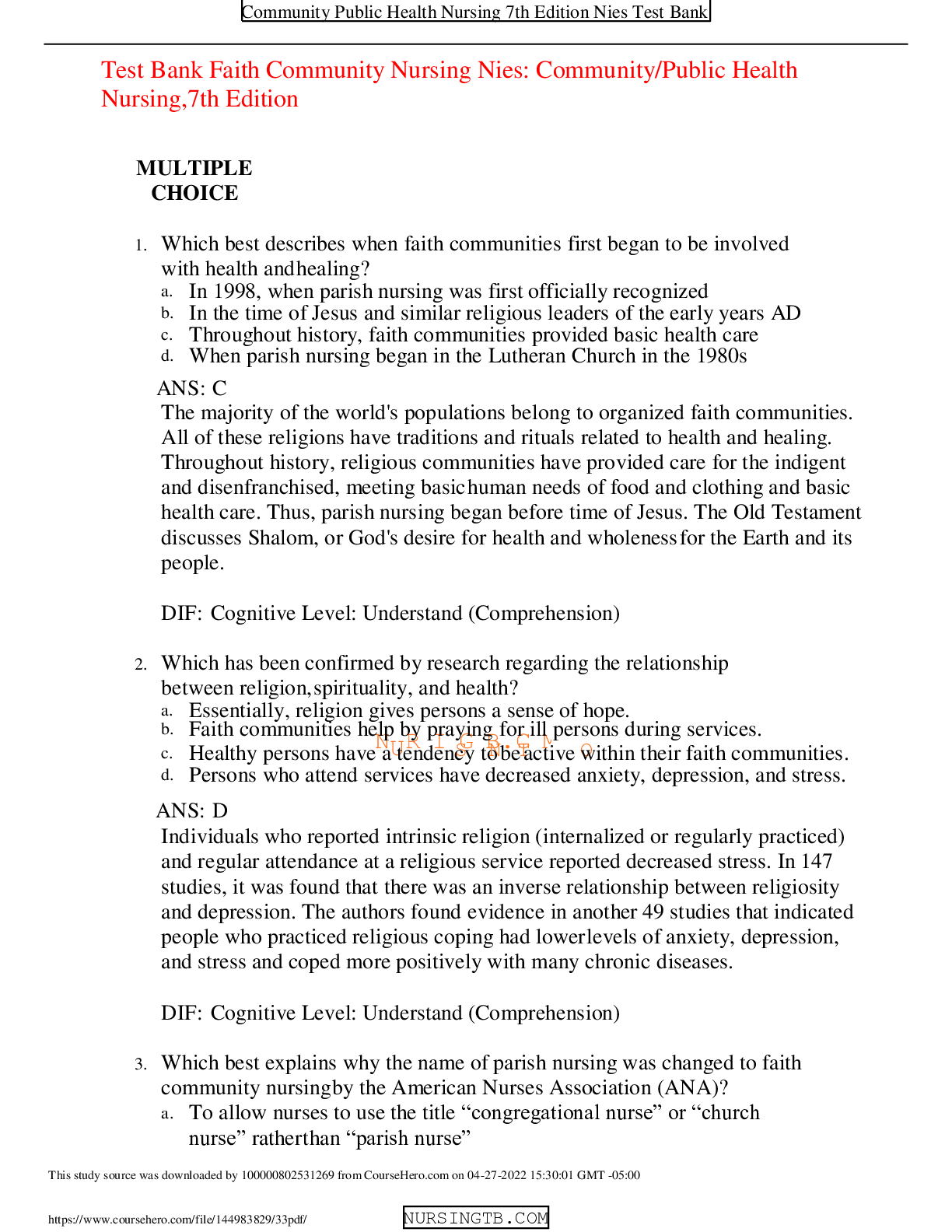*NURSING > TEST BANK > Test Bank Homeless Populations Nies: Community/Public Health Nursing, 7th Edition,100% CORRECT (All)
Test Bank Homeless Populations Nies: Community/Public Health Nursing, 7th Edition,100% CORRECT
Document Content and Description Below
Test Bank Homeless Populations Nies: Community/Public Health Nursing, 7th Edition MULTIPLE CHOICE 1. A family will most likely lose their primary nighttime residence within the next week. Whic... h term best describes their situation in relation to homelessness? a. Homeless under other federal statutes b. Literally homeless c. Imminent risk of homelessness d. Fleeing/attempting to flee intimate partner violence ANS: C The U.S. Department of Housing and Urban Development has issued regulations that summarized the statutory definitions in four descriptive categories. These four categories with their respective definitions include: Literally homeless: Individuals and families who lack a fixed, regular, and adequate nighttime residence, including a subset for individuals who resided in an emergency shelter or a place not meant for human habitation and who are exiting an institution where he or she temporarily resided; Imminent risk of homeless: Individuals and families who will imminently lose their primary nighttime residence; Homeless under other federal statutes: Unaccompanied youth and families with children and youth who are defined as homeless under other federal statutes who do not otherwise qualify as homeless under this definition; and Fleeing/attempting to flee DV: Individuals and families who are fleeing or are attempting to flee, DV, dating violence, sexual assault, stalking, or other dangerous or life-threatening conditions that relate to violence against the individual or a family member. N R I G B.C M DIF: Cognitive Level: Remember (Knowledge) 2. Which best describes the recent trends in homelessness? a. The number of homeless individuals in school is decreasing. b. The number of homeless individuals is increasing. c. The number of homeless families is increasing. d. The number of homeless families is decreasing. ANS: D The U.S. Department of Housing and Urban Development reported the following numbers of people in the total population and subpopulations who used shelters or transitional housing between October 1, 2015 and September 30, 2016: 355,212 individuals, a decrease of less than 1% between 2015 and 2016; 194,716 people in families with children, a decrease of 5% between 2015 and 2016. DIF: Cognitive Level: Understand (Comprehension) 3. On the basis of all the work done by social scientists, approximately how many homeless persons should be expected and tolerated in our society? a. No more than 5% b. No more than 10% c. No more than 15% d. There should not be homeless persons in America. ANS: D Kozol (1988) argued: “We would be wise to avoid the numbers game. Any search for the ‘right number’ carries the assumption that we may at last arrived at an acceptable number. There is no acceptable number. Whether the number is 1 million or 4 million, there are too many homeless people in America.” DIF: Cognitive Level: Remember (Knowledge) 4. Which represents the largest group of homeless adults? a. Minorities b. Disabled c. Females d. Males ANS: D Among all sheltered homeless adults in 2015, approximately 62.1% were men; 37.9% were women. The sheltered homeless population is younger than the general population. Most homeless adults were between 31 and 50 years of age; 22.3% were less than 18 years of age; and 4% were older than 62. In the general population, 18% were over age of 62. Minorities comprised 61.9% of the total sheltered population. Adults with disabilities were over three times more likely to be experiencing sheltered homelessness than adults without disabilities. DIF: Cognitive Level: Remember (Knowledge) 5. Which best describes the problem with the Section 8 housing program? a. Direct access to an apartment in a public housing facility is faster and easier. b. Most renters prefer the program to make direct payment to apartment owners willing to rent to them. NURSINGTB.COM c. Section 8 housing is essentially slum housing, and no one wants to live there. d. Supply is vastly less than the demand. ANS: D Although these programs are intended to alleviate housing problems for low-income renters, the demand for these assisted housing programs has far exceeded the supply. Section 8 housing does not provide direct access to an apartment in a public housing facility or provide payment directly from the program to apartment owners. Section 8 housing provides affordable housing through the U.S. Department of Housing and Urban Development and is not slum housing. DIF: Cognitive Level: Understand (Comprehension) 6. Which best describes what happens when persons who work full-time and receive the typical minimum wage seek an apartment? a. Few clean and decent low-rent apartments exist. b. People do not like to rent to low-income persons. c. To afford housing, they need a job that pays at least three times minimum wage. d. There are not many trailer parks near their employment. ANS: C An increasing number of low income people end up paying much more than they can afford for rent. Since 2007, the number of renters who pay more than half of their income for rent has increased dramatically. DIF: Cognitive Level: Understand (Comprehension) 7. Which factor would prevent a homeless person from accepting employment adequate to pay for housing? a. Could not complete an employment application because of lack of mailing address b. Hope for a better position than the service positions available c. Lack of adequate resources to pay for other necessities d. Prefer to receive a handout than to have to work ANS: C There are homeless people who are able to function in the workforce. The lack of affordable housing in combination with insufficient income results in people having to spend much of their income on rent and leaves them without adequate resources for other necessities, such as food, clothing, and health care. This situation substantially increases their risk for homelessness. DIF: Cognitive Level: Remember (Knowledge) 8. Which group of people is most likely to experience homelessness? a. Those who have a supportive family b. Those who have recently become unemployed c. Those who have substance abuse problems d. Those who frequently chNangeRjobIs G B.C M ANS: C U S N T O Some people experiencing homelessness have individual characteristics that, in interaction with the structural conditions of a shortage of affordable housing and insufficient income, perpetuate their homeless conditions. Supportive services for these people are deficient in quality and quantity. Some people need services to work and earn money. They are able to function in the workforce, whereas others need services to maintain their housing status. Included in this latter group are people whose serious chronic mental health and/or substance abuse problems preclude their functioning in the workforce and whose behaviors interfere frequently with their ability to obtain housing stability. People in this group need income assistance and comprehensive and accessible behavioral and physical health care. DIF: Cognitive Level: Apply (Application) 9. Which best describes how health care professionals are involved in the problem of homelessness? a. Homeless persons make everyone uncomfortable when they beg for handouts. b. Homeless persons often live in emergency departments and clinics. c. Poverty leads to crimes, and health care professionals can be attacked and robbed outside health care facilities. d. Serious illnesses or disability creates high medical bills, which may lead to homelessness. ANS: D In 2013, of households with an annual income less than $25,000, 21.6% had no health insurance. Lack of health insurance is a significant factor in creating homelessness. A serious illness or disability can lead to a downward spiral as a result of job loss, use of savings to pay for care, and inability to pay rent. DIF: Cognitive Level: Analyze (Analysis) 10. Which factors are most likely to contribute to homelessness? a. Intimate partner violence and substance abuse b. Scarcity of support systems and recent job loss c. Shortage of affordable housing and insufficient income d. Substance abuse and serious mental illness ANS: C The text addresses three broad factors: (1) shortage of affordable housing, (2) insufficient income, and (3) scarcity of supportive services as societal conditions that contribute to homelessness rather than cause homelessness. Intimate partner violence, substance abuse, and serious mental illness are not identified as the broad factor contributing to homelessness. DIF: Cognitive Level: Understand (Comprehension) 11. Which underlying factor most likely contributes to homelessness? a. Substance abuse b. Unemployment c. Posttraumatic stress syndrome (PTSD) d. Depression ANS: A NURSINGTB.COM The text states that persons as active agents do make decisions that result in homelessness. These choices result in a shortage of affordable housing, insufficient income, and scarcity of supportive services as societal conditions that contribute to homelessness rather than cause homelessness. However, these decisions are made in highly contextualized conditions, frequently in the midst of mental illness or addiction to alcohol and/or other substances. Substance abuse may in turn lead to unemployment which causes insufficient income. Additionally, PTSD and severe mental illness can cause substance abuse to occur. DIF: Cognitive Level: Understand (Comprehension) 12. Which individual would be described as being “doubled up”? a. An individual who has two chronic conditions b. An individual who has recently been released from prison c. An individual who maintains two jobs to avoid being homeless d. An individual who is forced to live with friends ANS: D An individual may be considered to be homeless if that person is “doubled up,” a term that refers to a situation where individuals are unable to maintain their housing situation and are forced to stay with a series of friends and/or extended family members. The other responses do not accurately describe being “doubled up.” DIF: Cognitive Level: Apply (Application) 13. Which person will have the most difficulty in obtaining adequate support services to find a long-term home? a. An alcoholic homeless person b. A homeless person who has a limited support system and is unemployed c. A homeless person who has a mental illness and is an alcoholic d. A mentally ill homeless person ANS: C For a sizable proportion of the homeless, severe mental illness exists along with the problems of alcohol or other types of substance use. Like physical health problems, serious mental illnesses and minor emotional problems occur more frequently among the homeless population than in the general population. High rates of alcohol and drug use exacerbate the existing acute and chronic physical and mental health problems. These coexisting problems can make it harder to assist the homeless person. DIF: Cognitive Level: Apply (Application) 14. Which best describes a major difference between women who have always had shelter and women who have been homeless? a. Educational opportunities and attainment b. History of gender relationships (marriages, divorces) c. Level of involvement with physical and/or sexual abuse d. Skills necessary for paid employment ANS: C Research has revealed the extraordinary histories involving substance abuse, criminal activity, serious mental health concerns, marital dissolution, escape from intimate partner violence, housing accidents, limited emNpUloRySmIenNt GopTtiBon.sCorOjMob loss, and poor physical health that prevented gainful employment, among women experiencing homelessness. High numbers of homeless women report histories of foster placement as children and exposure to violence as both children and adults. This research has not documented the differences in educational opportunities, gender relationships, and skills necessary for paid employment. DIF: Cognitive Level: Understand (Comprehension) 15. Which factor is the primary motivator for young (homeless) women engaging in survival sex? a. Peer influence b. Pursuit of drugs c. Coercion by perpetrators d. Desperation to meet basic needs ANS: D Young (homeless) women involved in survival sex (participating in sexual acts in exchange for money, food, lodging, clothing, or drugs) are motivated primarily by desperation to meet basic needs, including a place to stay, food, and money, and one third mentioned that peers commonly were influential in decisions to engage in survival sex. Others were influenced by coercion (10%) or pursuit of drugs (10%) (Warf et al., 2013). DIF: Cognitive Level: Remember (Knowledge) 16. A school nurse was asked to see Lisa, a student in the fourth grade who was rumored to be living in a car with her mother. Which would most likely have caused the teacher to become concerned? a. Lisa is not always respectful of the teacher. b. Lisa has not been doing her homework. c. Lisa is developmentally delayed. d. Lisa has behaved in a sexually inappropriate manner. ANS: C Homeless children experience STDs, physical and sexual abuse, skin disorders, anemia, drug and alcohol abuse, and unintentional injuries at higher rates than children in the general population. All children are not always respectful and do not always have their homework done and may act out behaviors seen on television. DIF: Cognitive Level: Apply (Application) 17. The male home health nurse parked his marked car in preparation for visiting the next client when a young female walked over to the car and asked him if he would like to have some fun. Which provides the best explanation for this behavior? a. The girl was skipping school and wanted money for entertainment. b. The male nurse was extremely young and attractive and looked like he had money. c. The girl may have hoped a nurse would give her enough money to eat. d. Young girls often engage in thrilling, if high-risk, behaviors. ANS: C Homeless youth experience sexually transmitted diseases, physical and sexual abuse, skin disorders, anemia, drug and alcohol abuse, and unintentional injuries at higher rates than in the general population. DepreNsUsioRnS, sIuNicGidTalBid.eCatOioMn, and disorders of behavior, personality, or thought also occur at higher rates among homeless. Family disruption, school failures, prostitution or “survival sex,” and involvement with the legal system indicate that homeless social health is severely compromised. Thus, it is most likely that the girl is hoping that the nurse would provide her enough money to eat. DIF: Cognitive Level: Apply (Application) 18. Which person would be called chronically homeless? a. A person has been homeless for more than a year b. A person who lives with a roommate when between jobs c. A person who has been staying with friends or family for an extended period of time d. A person has been residing each night in a homeless shelter for almost 3 months ANS: A The chronically homeless individual is defined as an unaccompanied adult who has been homeless for an extended or numerous periods and has one or more disabling conditions. DIF: Cognitive Level: Understand (Comprehension) 19. Which best describes the purpose of the Vulnerability Index? a. To identify those most at risk of becoming homeless b. To determine the underlying cause of homelessness among vulnerable populations c. To identify and prioritize the need for housing among the homeless d. To determine what resources should be provided for vulnerable populations ANS: C Homeless service providers, concerned about the high risk for mortality among “street” homeless population constructed the Vulnerability Index, a screening tool for identifying and prioritizing the need for housing. DIF: Cognitive Level: Understand (Comprehension) 20. Which are the most frequent problems suffered by the chronically homeless? a. Chronic conditions such as hypertension, bronchitis, and emphysema b. HIV/AIDS and other sexually transmitted diseases, tuberculosis, and hepatitis C c. Respiratory infections, trauma, and skin disorders d. Severe mental illness and substance abuse disorders ANS: D Chronically homeless people may well have many physical conditions, but the primary problems that lead to their homelessness are severe mental illness and substance use disorders. DIF: Cognitive Level: Remember (Knowledge) 21. Which statement best reflects the model of justice U.S. health care is based on? a. All people are entitled to minimum standards of care. b. All people are responsible to help their neighbors. c. All people have a right to whatever their own efforts allow them to purchase. d. Like firefighting, police protection, libraries, and roads and highways, health care must be supported by taxNmUoRneSyIfoNrGthTeBgo.oCdOofMall who need such services. ANS: C Market justice has been the dominant model and purports that people are entitled to valued ends (i.e., status, income, and happiness) according to their own individual efforts. Moreover, this model stresses individual responsibility, minimal collective action, and freedom from collective obligations other than respect for another person’s fundamental rights. In contrast, under a social justice model, all people are equally entitled to key ends (i.e., access to health care and minimum standards of income). Consequently, all members of society must accept collective burdens to provide a fair distribution of these ends. DIF: Cognitive Level: Understand (Comprehension) 22. Which describes a dimension of the social determinants of health (SDH) defined within Healthy People 2020? a. Employment b. Education c. Gender d. Income ANS: B Five broad dimensions of SDH are defined within Healthy People 2020 as: (a) Economic Stability, (b) Education, (c) Social and Community Context, (d) Health and Health Care, and (e) Neighborhood and Built Environment. Each of these dimensions includes key issues that identify more specific factors (U.S. Department Health and Human Services Healthy People 2020, 2013). Employment, gender, and income are not addressed as dimensions of the social determinants of health within Healthy People 2020. DIF: Cognitive Level: Remember (Knowledge) 23. Which best describes a downstream intervention to solve the problem of homelessness? a. Improved use of community resources b. Increased employment opportunities c. Increased affordable housing d. Improved treatment of mental illness ANS: D Building on McKinlay’s “river” metaphor, McKinlay and Marceau (2000) purport that government and private efforts to address homeless health care problems largely focus on “pulling the bodies out of the river of homelessness.” Such downstream interventions aimed at treating or alleviating health care problems, such as physical disease and mental illnesses, are worthy and needed. However, these interventions when used alone are far less adequate in alleviating homeless people’s social health problems. To improve the social health of the homeless, it is necessary to go upstream and focus on the primary contributors to homelessness itself (i.e., lack of affordable housing, inadequate income, and insufficient services). DIF: Cognitive Level: Apply N(ApRplicaItionG) B.C M U S N T O 24. A nurse is using an upstream intervention when working with the homeless population. Which public health intervention will the nurse most likely use? a. Case management b. Outreach c. Surveillance d. Community organizing ANS: D Although nurses may use all interventions at all three levels, community/public health nurses working more upstream, at the system level, employ collaboration, coalition building, community organizing, advocacy, social marketing, and policy development and enforcement. In contrast, community/public health nurses—working downstream with individuals, families, or groups—use surveillance, disease and other health event investigation, outreach, screening, case finding referral and follow-up, case management, delegated functions, health teaching, counseling, and consultation. DIF: Cognitive Level: Apply (Application) MULTIPLE RESPONSE 1. Which best describes the term “literally homeless”? (Select all that apply.) a. Lacking a fixed, regular, and adequate nighttime residence b. Lacking a family residence c. Living in a place not typically used for human sleeping d. Living in a temporary living accommodation such as a hotel e. Living full-time in a recreational vehicle f. Sleeping in an extended-care facility or hospital ANS: A, C Literally homeless is described as individuals and families who lack a fixed, regular, and adequate nighttime residence and includes a subset for an individual who resided in an emergency shelter or a place not meant for human habitation and who is exiting an institution where he or she temporarily resided. The term “literally homeless” is not used to describe those lacking a family residence, living in a temporary living accommodation such as a hotel or recreational vehicle, or sleeping in an extended care facility or hospital. DIF: Cognitive Level: Remember (Knowledge) 2. Which strategies have been used to improve the collection of prevalence data for the homeless population? (Select all that apply.) a. Urban Institute study b. Homeless Assistance Report c. Continuum of Care (CoC) concept d. Homeless Information Management System (HMIS) e. Census Bureau f. Education for Homeless Children and Youth program ANS: C, D Two strategies used by the U.S. Department of Housing and Urban Development in the efforts to strengthen the nation’s effNorUtsRtoSrIedNuGceThBom.CeleOsMsness, including improvement in collecting prevalence data, are the CoC concept and the HMIS. The Census Bureau and Urban Institute study were historically used to collect data on the homeless population. Data collection improvements have been made since these studies were completed. The Department of Education uses the Education for Homeless Children and Youth program to collect data on homeless youth. DIF: Cognitive Level: Remember (Knowledge) 3. Which best describes how the Continuum of Care (CoC) concept determines the number of homeless? (Select all that apply.) a. By asking local police departments to visit areas where the homeless hide and report the number of people found there each March b. By conducting a point-in-time (PIT) homeless persons count every other January c. By making an educated guess based on anecdotal data d. By completing a statistical analysis of the Census Bureau data e. By reporting the number of homeless persons who use emergency shelters or transitional housing during the year f. By sending CoC personnel into the community to try to find hidden homeless ANS: B, E CoCs are local systems responsible for providing a range of housing and related services that meet the U.S. Department of Housing and Urban Development guidelines for persons experiencing homelessness. CoCs conduct PIT counts of homeless persons on one night in January of every other year. In addition, CoCs are required to report the number of homeless persons who use emergency shelters or transitional housing throughout each federal fiscal year. DIF: Cognitive Level: Understand (Comprehension) 4. Which disorders are experienced at a higher rate by homeless adults when compared with the general population? (Select all that apply.) a. Hepatitis b. Diabetes c. Asthma d. HIV/AIDS e. Hypertension f. Alcoholism ANS: C, E, F Chronic disorders experienced at higher rates than in the general population include hypertension; musculoskeletal disorder; gastrointestinal problems; respiratory problems (asthma, chronic bronchitis, emphysema); neurological disorders, including seizures; and poor dentition. Like physical health problems, serious mental illnesses and minor emotional problems occur more frequently among the homeless population than in the general population. High rates of alcohol and drug use exacerbate the existing acute and chronic physical and mental health problems. The rates of hepatitis, diabetes, and HIV/AIDS are not seen at a higher rate among tNhe hRomIelesGs adBul.t pCopuMlation. U S N T O DIF: Cognitive Level: Understand (Comprehension) [Show More]
Last updated: 1 year ago
Preview 1 out of 19 pages

Reviews( 0 )
Document information
Connected school, study & course
About the document
Uploaded On
Apr 20, 2022
Number of pages
19
Written in
Additional information
This document has been written for:
Uploaded
Apr 20, 2022
Downloads
0
Views
27

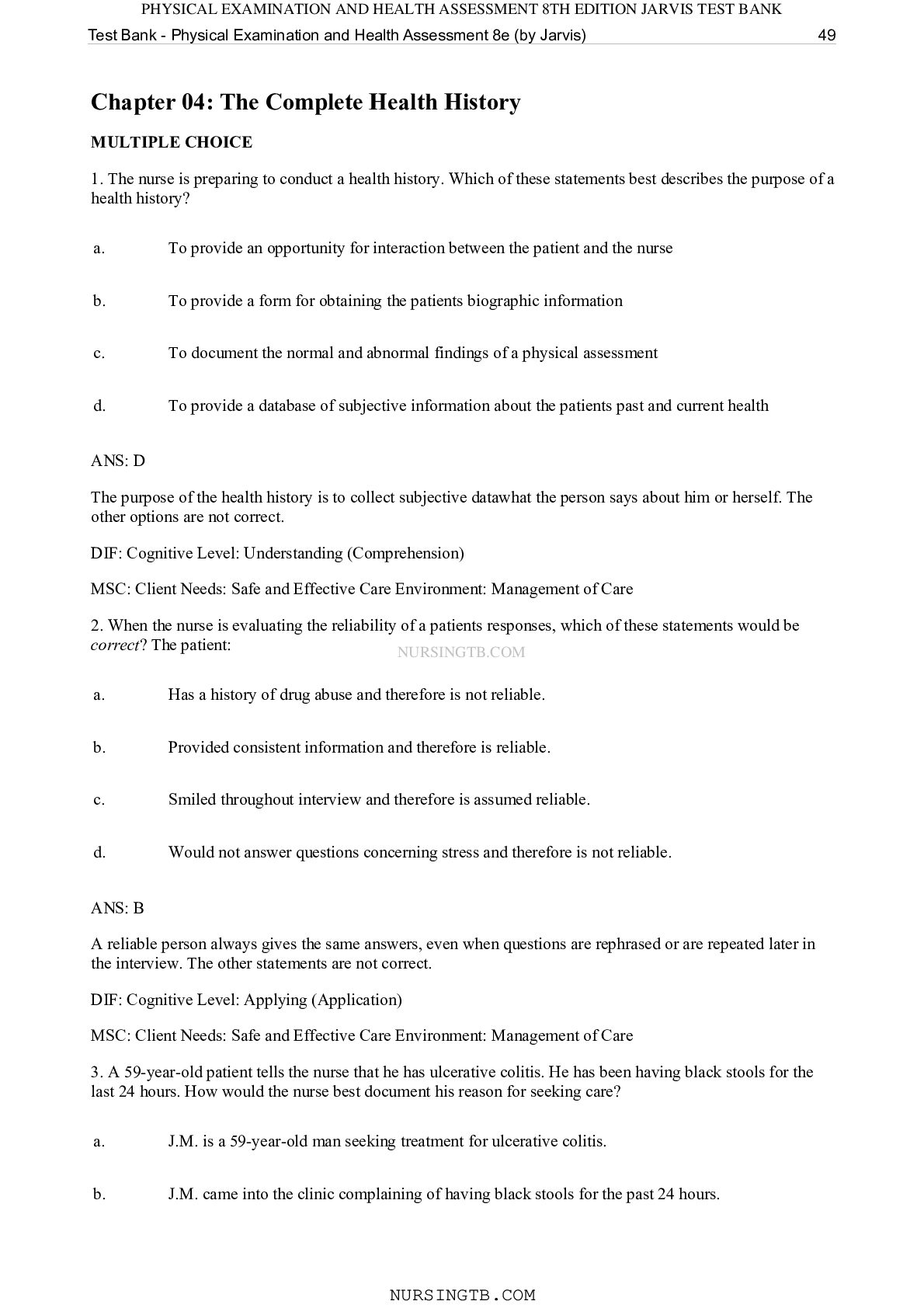









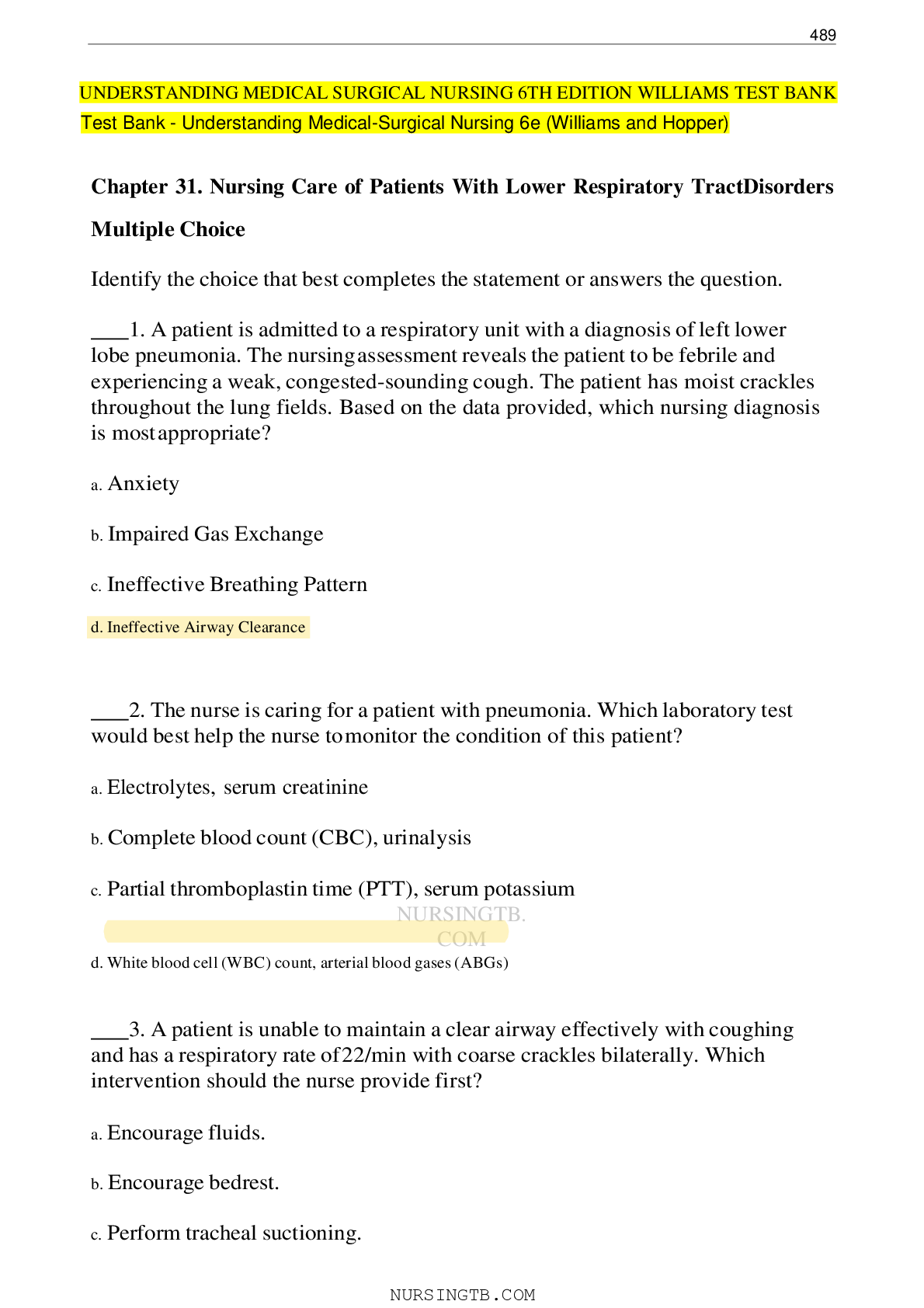

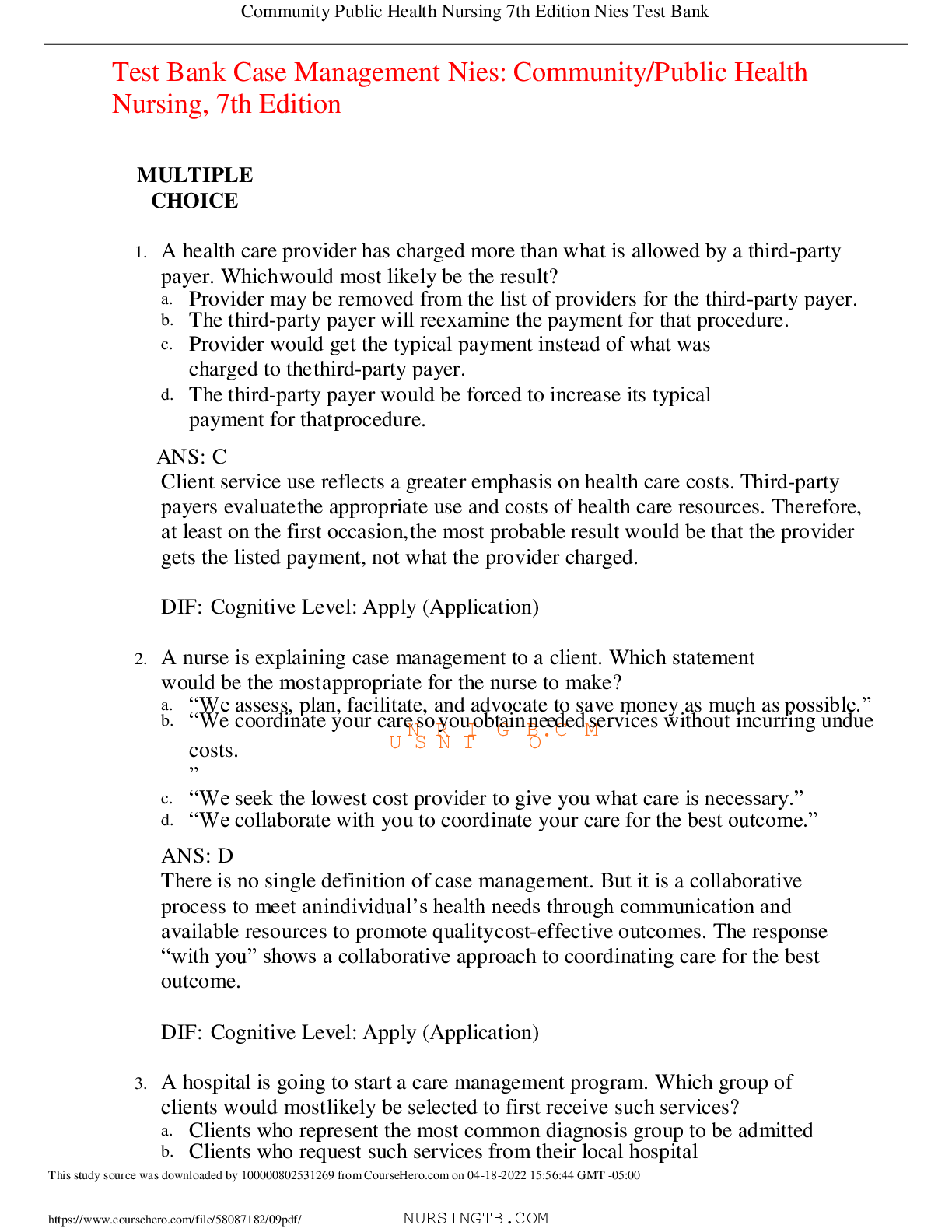

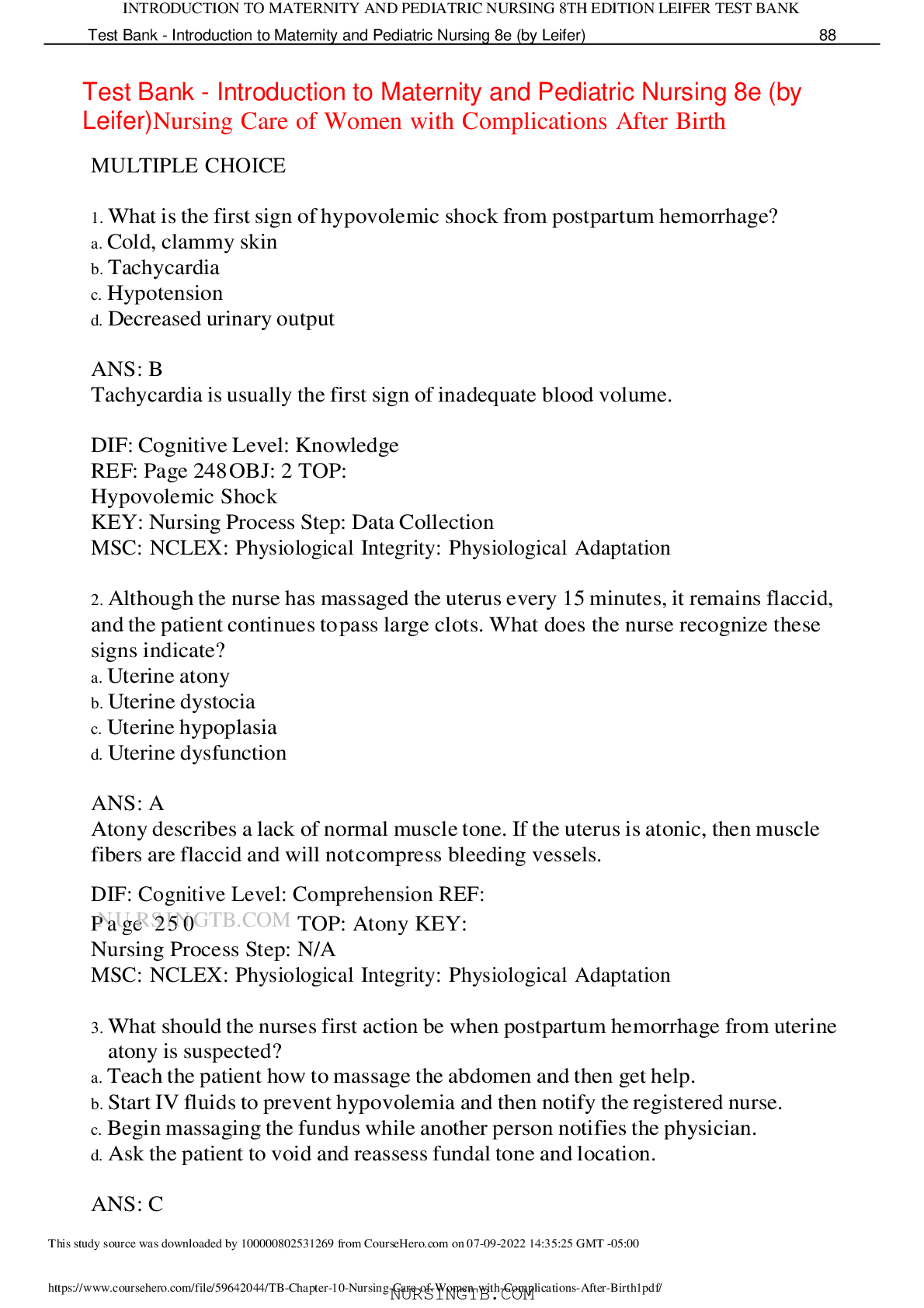



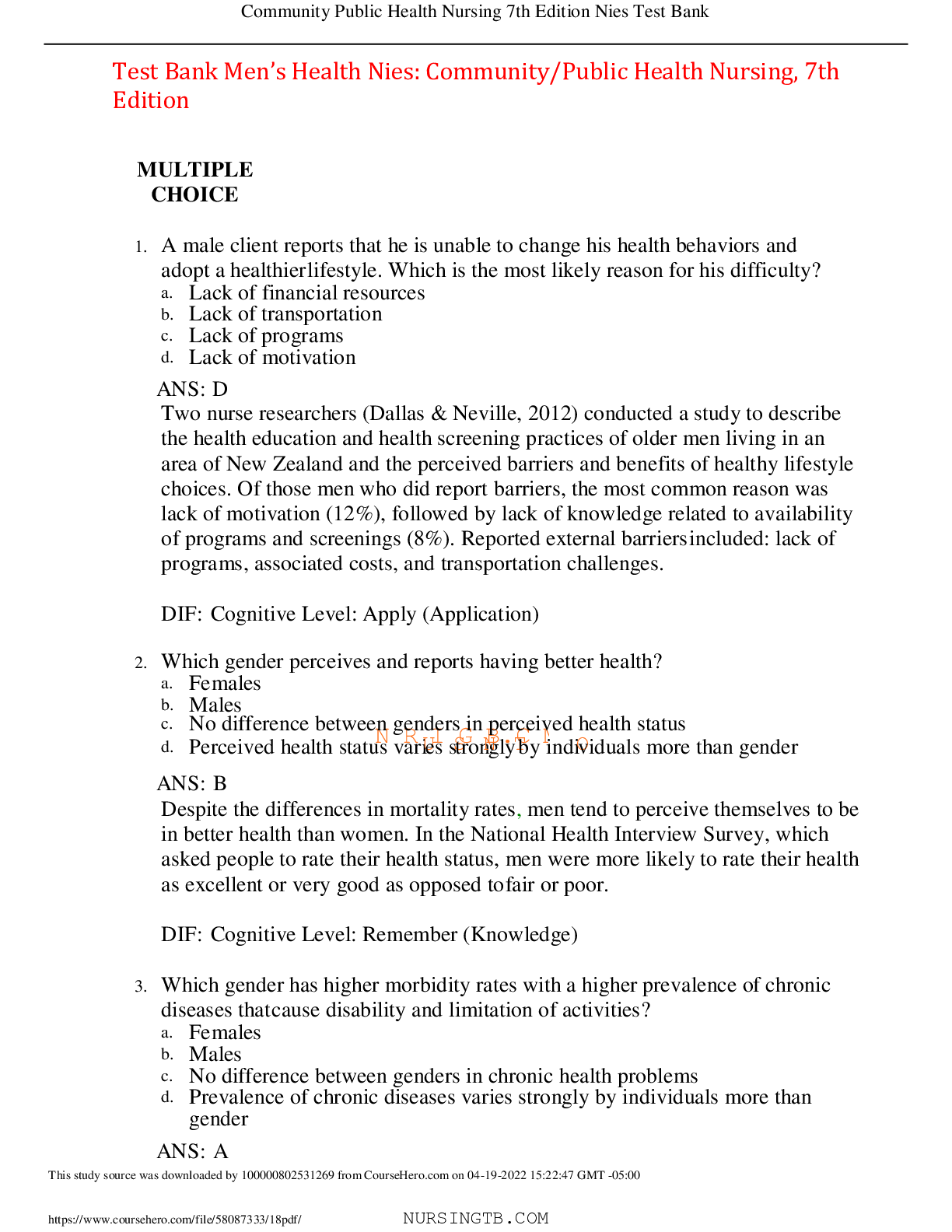
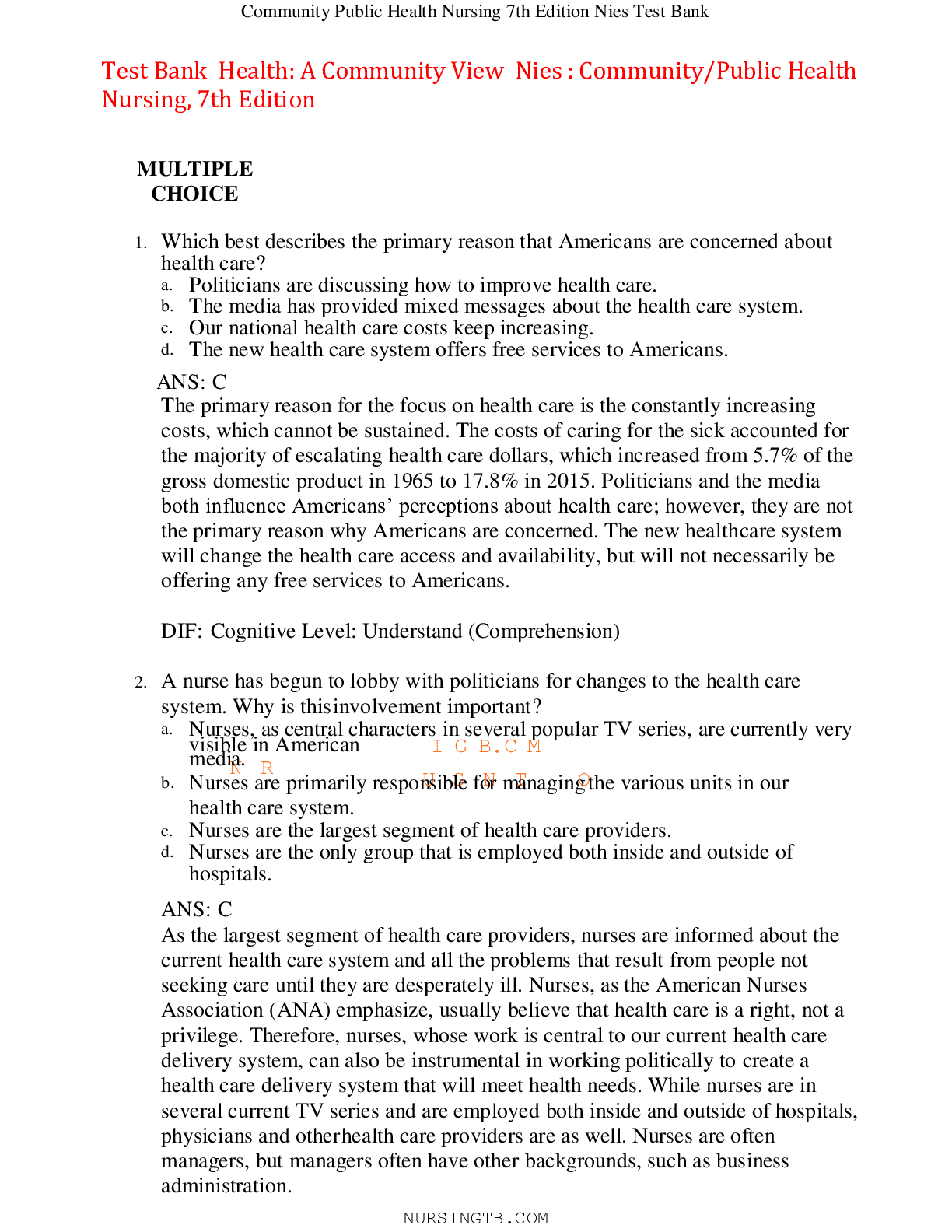
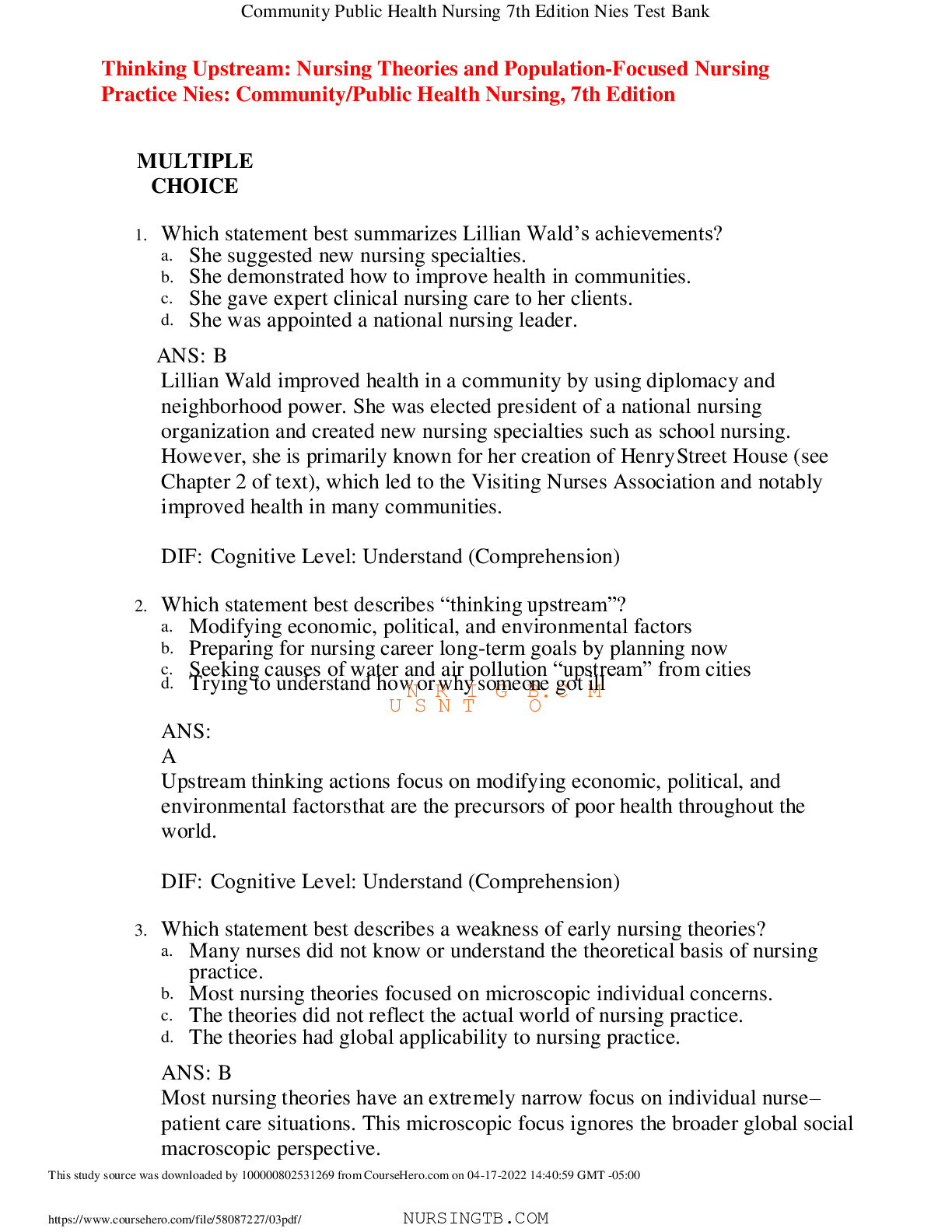

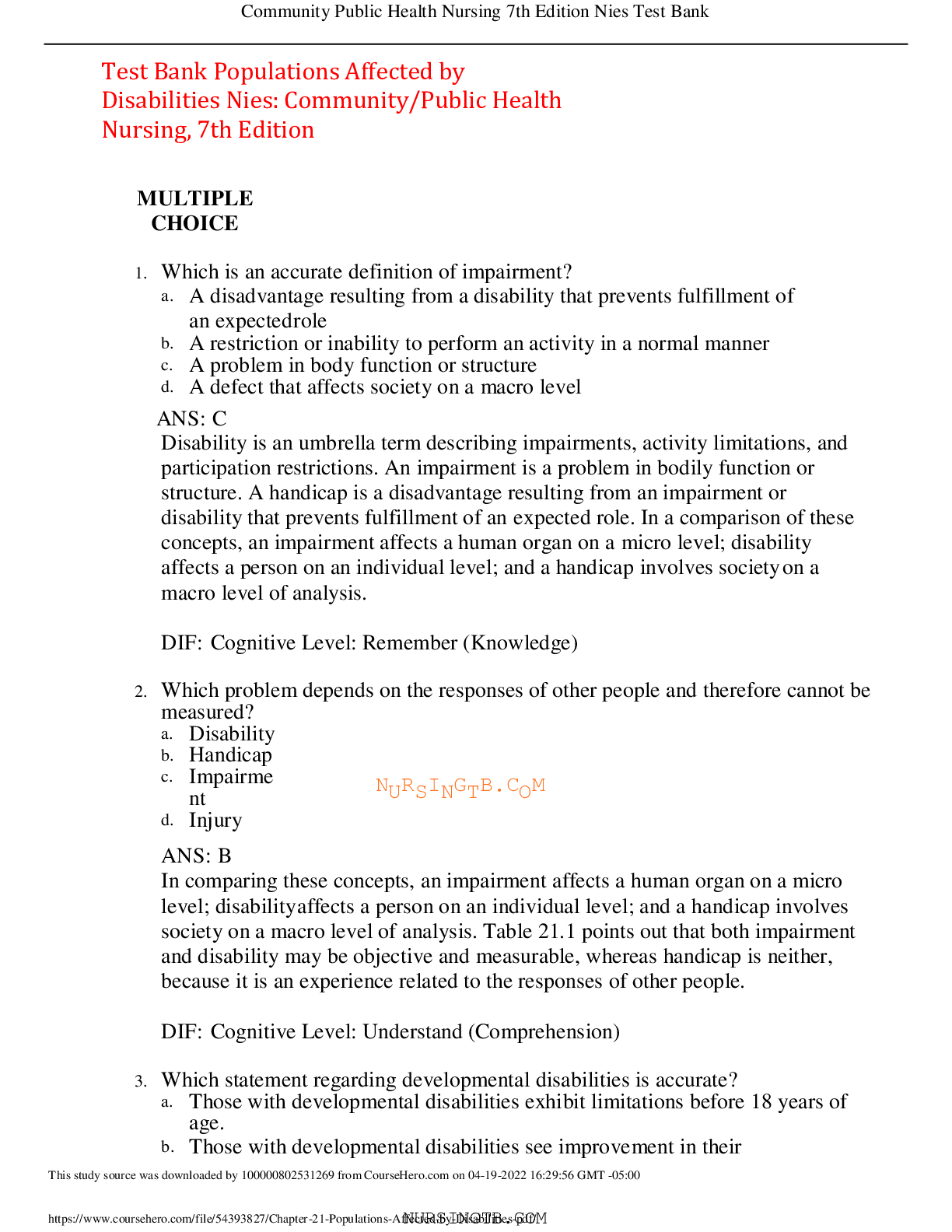


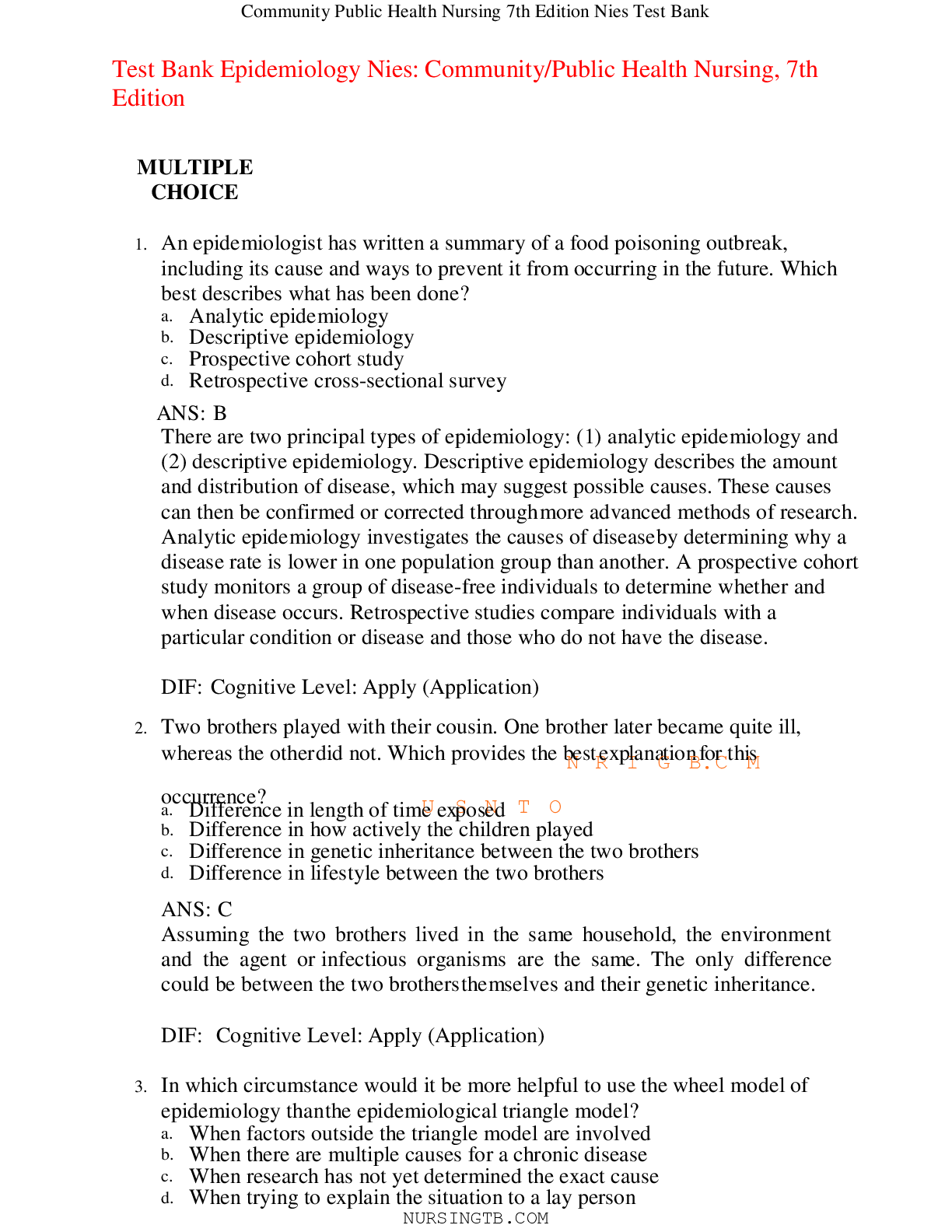
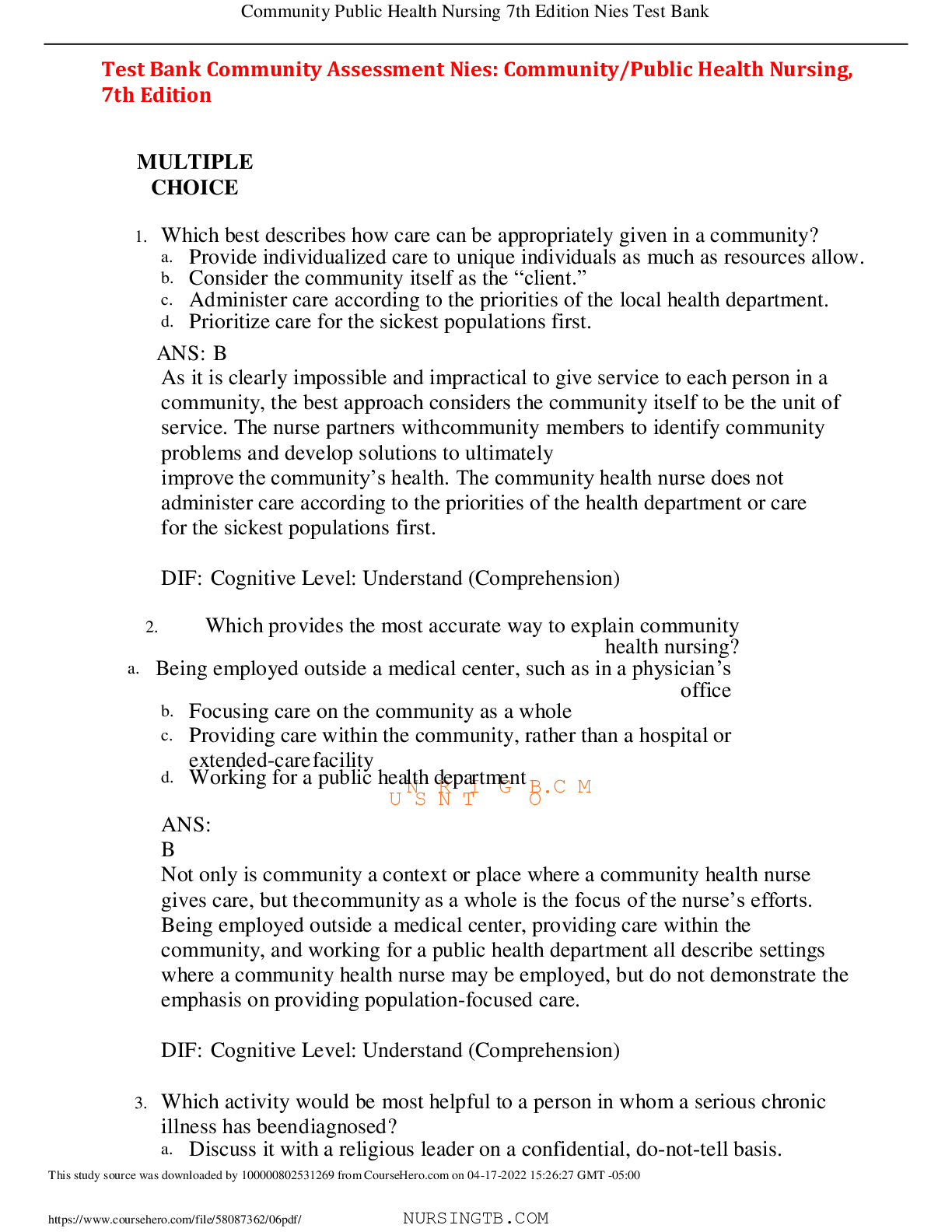

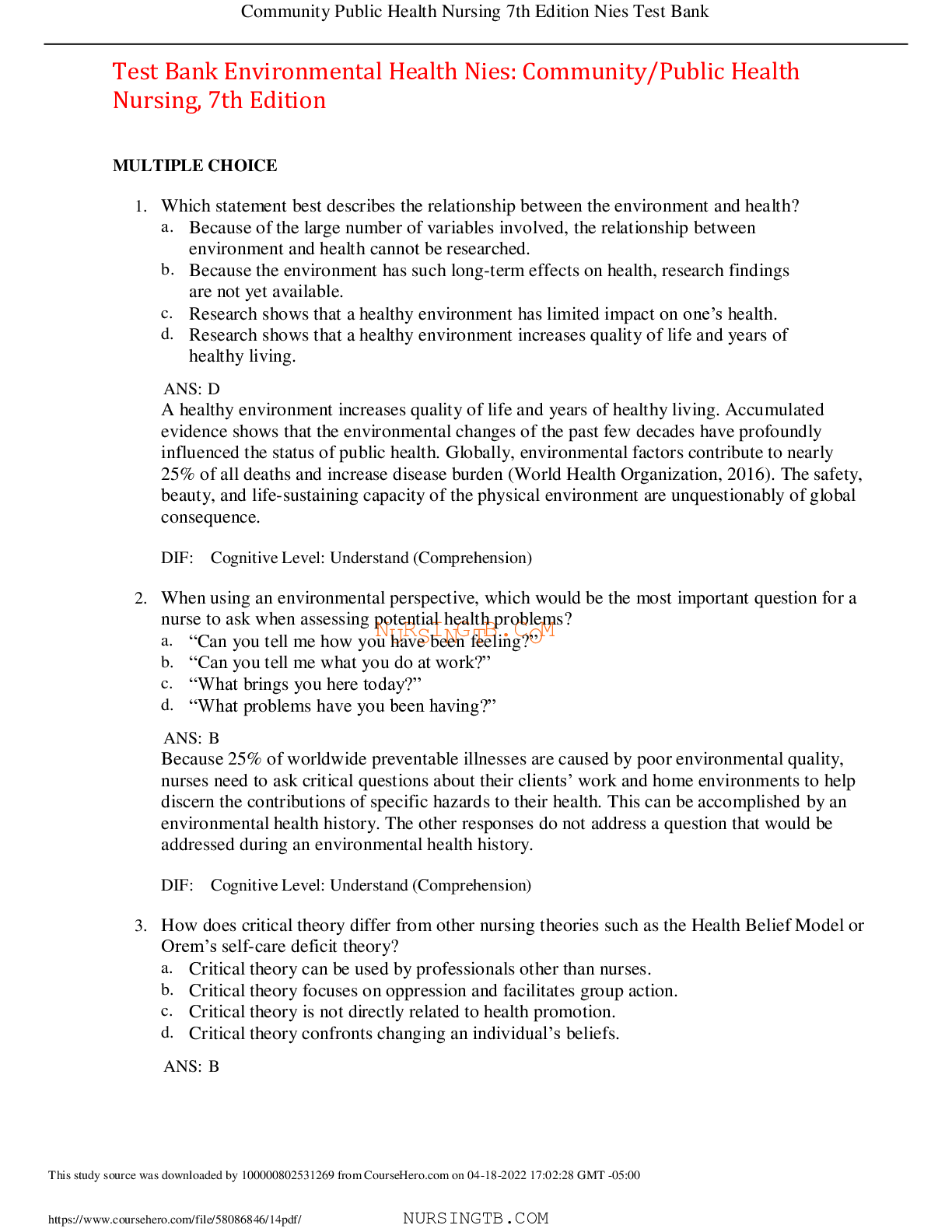
.png)

